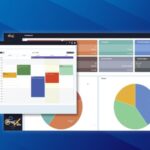When the topic of big data comes up, there is an apropos and often repeated quote from the classics of English literature, “Water, water everywhere, but not a drop to drink.” It is from Samuel Taylor Coleridge in his poem The Rime of the Ancient Mariner, a poem about stranded seamen who, despite being surrounded by something (in this case sea water), could not benefit from it. Think about this quote and substitute the word “data” for water.
We are surrounded not just by data, but by big data which leads us to ask: what are the key big data uses, what does it actually refer to, who benefits from it, and where does the commercial AV world fit in?
Big data definition
The term big data has been in use since the 1990s. Overall, big data is an umbrella term referring to the analyses and extraction of information via data sets that are too large or complex to be dealt with by traditional data-processing application software.
The most common use of big data is for predictive analytics. This refers to the practice of extracting information from existing data sets in order to determine patterns (including human behavior) and predict future events and trends.
Predictive analytics uses many techniques from data mining, statistics, modeling, machine learning, and artificial intelligence to analyze current data to make predictions about future.
In short, big data is the raw material of the digital information age telling us what is going on, what trends are developing, and postulating where we are most likely headed. The holy grail of big data is to provide insight into predictable outcomes.
Types of big data
The next step in our journey is to understand types of data, that it is not all the same and of equal value. Where the data sets come from will determine how they need to be addressed.
Experts break down data into two camps. Some data is structured and quantitative in nature, but approximately 80% is unstructured and qualitative.
Structured data is highly organized and formatted in a way so it’s easily searchable in related databases. Unstructured data has no pre-defined format or organization, making it much more difficult to collect, process, and analyze.
Structured data is the most common type we are used to working with.
Think of numerical data in fields and columns i.e. spreadsheets, employee information, credit data, etc.
Structured data is highly organized and easily understood by machine language. A person can input, search, organize, and format structured data relatively easily and quickly.
Unstructured data is often described as qualitative because it can’t be processed and analyzed using conventional tools and methods used with structured data.
Examples of unstructured data include both audio and video but also, mobile communication, social media, etc. Unstructured data is difficult to “deconstruct” into a data set because it has no pre-defined model, meaning it cannot be organized in structured databases.
Keep in mind that 80% of big data falls under the category of unstructured.
Data mining experts note that “finding the insight buried within unstructured data isn’t an easy task. It requires advanced analytics and a high level of technical expertise to really make a difference.
This can be an expensive shift for many companies.” The task at hand for companies is to find those insights in the unstructured data “dump” and as a result gain a competitive advantage. Unstructured data can give a company a much deeper understanding of end user behavior, intent, and predictability.
There is data expert consensus on specific attributes surrounding big data.
Data experts commonly call these the five V’s:
- Volume is the main characteristic that makes big data, big. We are growing in excess of 50% per year over year in order of magnitude.
- Variety is the combination of structured and unstructured data. With unstructured data, there are no rules and so no limit to what can be made available. One of the goals of big data is to use technology to take this unstructured data and make sense of it.
- Veracity refers to the trustworthiness of the data. Is the data representative and what are the inherent discrepancies? The ultimate goal is a purity of data.
- Velocity is the frequency of incoming data that needs to be processed.
- Value is the objective and combines the preceding four attributes. Will the insights you gather from big data analysis provide something of value?
The final attribute, the value of big data, brings us to analytics. Big data analytics is a form of advanced analytics, which involves complex applications with elements such as predictive models, statistical algorithms and what-if analysis powered by high-performance analytics systems.
Collecting data is one thing and analyzing it is quite another.
The implementation of robust big data analytics “offers a nearly endless source of business and informational insight, that can lead to operational improvement and new opportunities for companies to provide unrealized revenue across almost every industry.”
The true value is hidden within a company’s specific use case scenario. Each company must uncover this on their own correlated to their objectives. It may range from customer behavior analysis to internal operations, to risk analysis, and beyond.
The data collected changes every day and must be addressed accordingly and appropriately. Today, if data and its analysis is ignored, opportunity is wasted, and risk incurred.
Harvesting big data and excising the value poses many challenges for companies and their IT teams.
Companies have differing needs and different availability of data mining assets. Keeping up with the ever-increasing flow of information requires as one expert notes “both agility and scalability”.
Effective big data analytics requires significant computing resources, technological infrastructure, and most importantly highly skilled personnel.
In the past, this may have been too expensive for all but the largest of companies but with the rise of cloud computing and new technologies in computer resource management, big data tools are more accessible and affordable than ever before.
So, what is the return on investment for big data analytics?
Driven by specialized analytics systems and software, as well as high-powered computing systems, big data analytics offers various business benefits in the form of ROI, including (but not limited to) the following:
- New revenue opportunities
- More effective marketing
- Better customer service
- Improved operational efficiency
- Competitive advantages over rivals
- Enhanced predictability and reduced risk
The bottom line is that at some level a company must participate in data analytics or fall to the wayside by not having sufficient information with which to do business and compete.
Where it fits in to Pro AV
Now that we understand more about big data and analytics, where does the commercial AV integration community fit into this onslaught of information?
It can be traced to connected devices and the latest buzz phrase IoT. Big data is facilitated by connected devices and this is where IoT comes into play and all who practice the science, art, and craft of commercial AV design and integration.
It is imperative for us to know and apply how all these factors work in conjunction with one another as we interact with clients and their expanding needs.
In its basic form, the Internet of Things (IoT) describes an interconnected network of physical devices that are embedded with sensors, software, and other technologies for the purpose of connecting and exchanging data with other devices and systems over the internet.
The proliferation of these devices and the design and integration of them into systems is where we exist in commercial AV.
There are more than 7 billion connected IoT devices today, experts are expecting this number to grow to 10 billion by 2020 and 22 billion by 2025. The latest market research shows the industrial IoT Market worth $105.4 billion by 2025.
It has been accurately described as our hyperconnected world, with digital systems that can record, monitor, and adjust each interaction between and among connected things.
Big data and IoT is omnipresent. All this should play directly into the hands of the commercial AV community, providing our industry with a vast array of new design, integration, and service opportunities if we are ready, willing, and able to take advantage of them.
We no longer reside in the realm of hardware and remote control alone. Our task and new opportunities are to understand all the implications of what that new hardware can do beyond where it resides.
It becomes a matter of connectivity between and among devices. It is not about a room but rather a building or an entire campus or environment. Connectivity is about communication.
It may be one to one, one to many, or increasingly machine to machine. The output of all of this is data and increasingly big data. Analytics tells companies what to do with that. Analytics necessitates monitoring and all of this combined provides the next set of big opportunities for us all.













